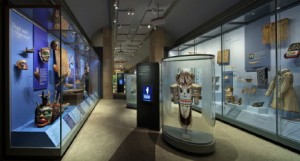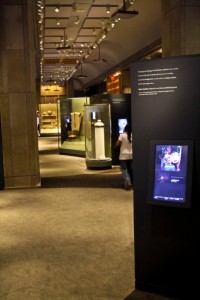Electrosonic’s Screens At The National Museum Of The American Indian
Gail Chiasson, North American Editor
Electrosonic is helping visitors to the National Museum of the American Indian in Lower Manhattan to discover the beauty of Native American artifacts and the stories behind those stunning objects in the new permanent exhibition, ‘Infinity of Nations: Art and History in the Collections of the National Museum of the American Indian’, scheduled to be in place for the next decade.
 Electrosonic. Burbank, California, engineered, provided and installed 20 exhibits for ‘Infinity of Nations’, including 10 linear video stations and 10 interactive workstations housed in the NMAI’s George Gustav Heye Center in the Old Customs House. Five years in the making, the new permanent collection reflects the geographic and chronological scope of the museum’s collection, and includes magnificent headdresses, robes, beadwork, baskets and vessels, as well as works by contemporary Native American artists.
Electrosonic. Burbank, California, engineered, provided and installed 20 exhibits for ‘Infinity of Nations’, including 10 linear video stations and 10 interactive workstations housed in the NMAI’s George Gustav Heye Center in the Old Customs House. Five years in the making, the new permanent collection reflects the geographic and chronological scope of the museum’s collection, and includes magnificent headdresses, robes, beadwork, baskets and vessels, as well as works by contemporary Native American artists.
With 700 objects on display, NMAI puts a new emphasis on aesthetics, beauty and art in the newly renovated Old Customs House. The artifacts, arranged by geographical region from the tip of South America to the Canadian Arctic, are supplemented by the 10 linear video stations that display video clips, short texts and brief interviews with historians who help relate their stories. The stations comprise 15” Boland monitors with Alcorn McBride Binloop solid-state players.
The 10 Electrosonic interactive workstations highlight focal-point objects representing each region, including a Mayan bas-relief depicting a ball player, an elaborately-beaded Inuit woman’s inner parka, a Chumash basket with a Spanish-coin motif and a Mapuche hand drum illustrating the cosmos. The interactive stations consist of Dell workstations, ELO 22” touchscreens and Dakota overhead directional sound arrays that were color matched to blend into the ceiling.
 Playback for the linear video stations and computers for the interactive workstations is housed in the museum’s basement control room. Due to the distance, Magenta Cat 5 video extensions were required to feed signals more than 500 feet to the second-floor gallery. The control room also includes signal monitoring, DSP processing and a new AMX control system.
Playback for the linear video stations and computers for the interactive workstations is housed in the museum’s basement control room. Due to the distance, Magenta Cat 5 video extensions were required to feed signals more than 500 feet to the second-floor gallery. The control room also includes signal monitoring, DSP processing and a new AMX control system.
“The network-based control system enables us to monitor things remotely and detect trouble before it becomes an issue,” says Bryan Abelowitz, Electrosonic senior sales consultant. “NMAI has limited technical resources in-house, so everything was designed to be fairly automatic and extremely simple to use.”
Electrosonic provides ongoing support and maintenance of the control-room facility.

Follow DailyDOOH